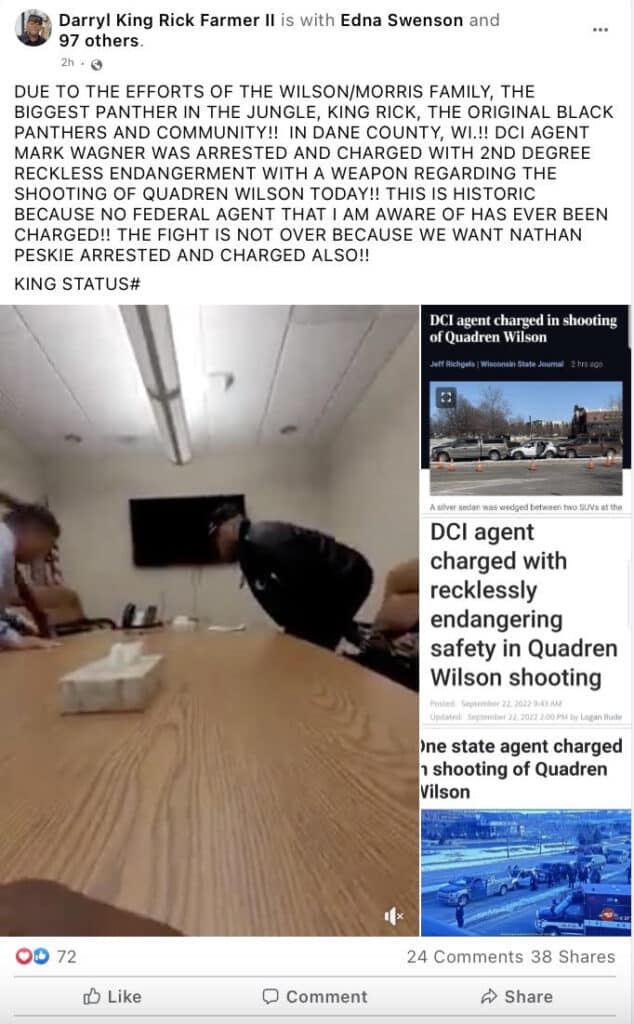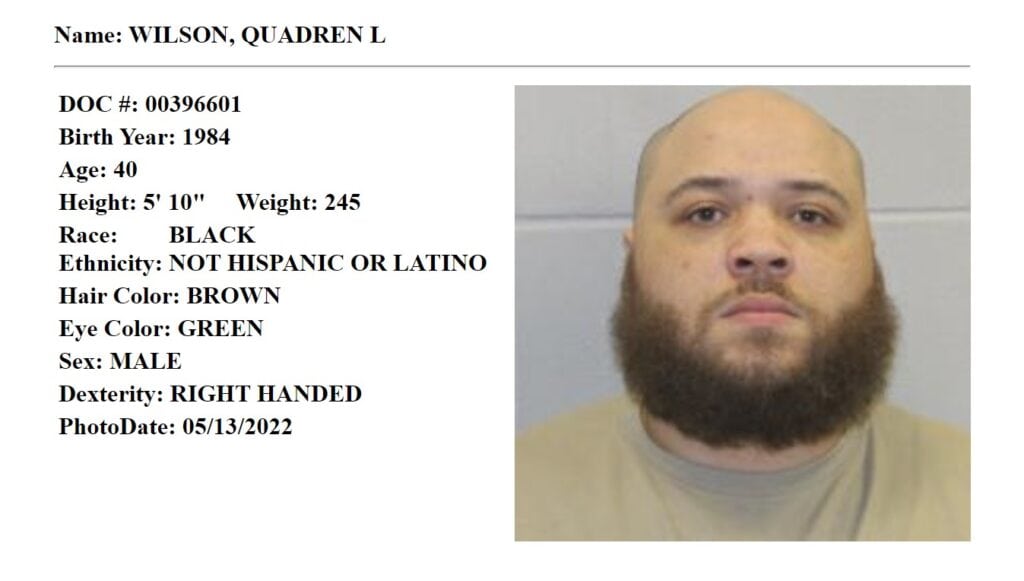State Department of Justice special agent Mark Wagner is on trial in Dane County in a reckless, unfair prosecution that should never have been brought.
Wisconsin law says that officers must be reasonable, not necessarily right, to use lethal force. They have to reasonably believe that their life or that of another is in imminent danger.
Wagner shot at violent felon Quadren Wilson, who, it turned out, was unarmed. Wagner was part of a group of agents trying to apprehend Wilson in February 2022, who was in a car. He was wanted for allegedly dealing fentanyl that led to an overdose death. However, the evidence also shows that Wagner reasonably believed he had been shot by Wilson when he opened fire (missing Wilson by the way.) Another agent on the team had smashed a window with a crowbar-like tool. It’s likely that this is what Wagner heard, and a projectile may have struck and damaged his shield.
Thus, Wagner’s decision to open fire was reasonable, and prosecuting him at all is a miscarriage of justice. Hopefully, the Dane County jury will see this. But, of course, it’s Dane County.
It begs the question of whether this was a DA who caved to a woke agenda. Before he charged Wagner, District Attorney Ismael Ozanne met with “King Rick,” the leader of the Black Panthers in Milwaukee. King Rick later gloated about the charges on social media.

The U.S. Supreme Court has defined reasonableness as follows: “The ‘reasonableness’ of a particular use of force must be judged from the perspective of a reasonable officer on the scene, rather than with the 20/20 vision of hindsight.”
As cited in the criminal complaint against Wagner, a person is entitled to use self-defense to prevent or terminate what the person “reasonably believes to be an unlawful interference with his or her person.”
Division of Criminal Investigation policy also emphasizes reasonableness: An agent may use deadly force “only when the agent reasonably believes they are facing an imminent threat of death or great bodily harm to themselves or others.”
“The evidence is going to show that something went really wrong here,” liberal District Attorney Ismael Ozanne said during the trial. He’s not wrong that something went wrong. It was a chaotic messy scene involving many officers. However, that doesn’t mean it was criminal. That doesn’t mean that a dedicated agent who was asked to make a split-second judgment should be facing 10 years in prison on a second-degree recklessly endangering safety charge.
The DA has fixated during the trial on the fact Wilson did not actually have a weapon. But the absence of a gun doesn’t mean Wagner did not reasonably believe one had been fired. And that’s where Ozanne fails.
Here are 9 reasons the prosecution of Wagner is an outrageous abuse of power. Most of the facts are from the criminal complaint itself; some are from defense motions and websites. This prosecution is so flawed that the prosecutor’s own document makes the case in FAVOR of Wagner.
- The Felon Stopped By Mark Wagner Is an Exceptionally Dangerous Repeat Criminal
The person who endangered safety that day? Quadren Wilson, the felon Wagner was trying to apprehend. In fact, Wilson has pretty much been endangering safety for years.
Wagner and his colleagues were trying to arrest the “violent career criminal who had an outstanding arrest warrant” (for fentanyl drug charges), according to a website in Wagner’s defense. Wilson had a Department of Corrections warrant, according to the criminal complaint.

Wagner was part of a multi-jurisdictional unit tasked with apprehending him. The agents’ goal was to pin his vehicle between two law enforcement vehicles so they could safely take Wilson into custody. This is a well-established law enforcement tactic called a “SIC” maneuver, according to the complaint.
Check out Wilson’s record in the online court website. It’s shockingly long. Although someone’s criminal history isn’t a defense for using lethal force against them, we think it contributes to the dangerousness of the situation and, thus, Wagner’s reasonableness.
By the way – the state Department of Corrections website still lists Wilson as being on active community supervision! In fact, he was released through the state’s early release program on a felony drug dealing charge in the first place. Why wasn’t his release revoked? Instead, he was given $1,500 cash bail for a slew of new charges! For cocaine dealing as a repeater, near a park! He wasn’t charged until March 15; he testified in what appeared to be a jail uniform. According to VINE Link, he’s been in the custody of the Dane County Jail since only March 12.
Wagner and his colleagues knew the kind of person they were dealing with. Wilson is not a sympathetic character. He has a felony drug dealing conviction and convictions for being a felon in possession of a firearm and second-degree recklessly endangering safety (ironically). He has repeated convictions for fleeing an officer. He’s a felon multiple times over. His record includes intimidating a victim, bail jumping, criminal trespass, battery, escape, retail theft, and resisting.
Wilson was even on GPS monitoring while he was allegedly involved with fentanyl dealing. He is a scourge on the community. Yet Wilson whined during his testimony that he is suffering from PTSD. Get out the world’s smallest violin.
One of the DA’s arguments is that Wilson could have been arrested during a meeting with probation and parole instead, but that agent testified that she thought that would be dangerous. No kidding!
Wagner was not approaching a Boy Scout. This plays into his mindset. Yes, Wilson wasn’t armed this time. Wagner was wrong about that. But Wilson’s record certainly makes that mistaken belief more reasonable. The criminal complaint confirms that Wagner told investigators he knew Wilson had an extensive criminal history and was wanted on a warrant.
2. Wagner Thought he Heard a Shot and May Have Mistaken Another Officer’s Crowbar-style Tool Breaking a Window For It
This is the crux of the matter. In fact, we could stop and end here.
Wagner thought he was being shot at. And he had reason to think he was being shot at, even though he wasn’t.
A defense memo says that when a third officer attempted to break the rear driver’s window with the spiked end of a Halligan tool, it deflected off the window and became stuck in the space between the window and the outside door panel of Wilson’s car. That agent “had to hit the tool upward” to free it and then swung it a second time and shattered the glass. He then saw Wagner stumble, the memo says.
Many people saw Wagner stumble. And those people thought he had been shot, court documents say.
For example, yet another agent heard a “loud pop” before seeing Wagner fall, the defense memo says, and he thought Wagner was shot.
Indeed, something hit Wagner’s shield, the memo says.
Wagner heard what he thought was a gunshot and felt something hit him and push him backward. That’s when he thought, “He’s shooting me.”
A citizen witness verified that she saw Wagner appear to be flying backward.
This happened extremely quickly. Wagner fired one round from his handgun almost simultaneously with hearing the possible gunshot, the complaint says.
“I was trying to stop him from shooting me,” Wagner said. He was trying to stop Wilson from shooting his partner. He believes Wilson was trying to kill them.
So, if Wagner was wrong about being shot at, what did he hear?
During the trial, according to the State Journal, Wagner’s attorney asked whether he might have heard the “impact of an errant Halligan tool” that was used to smash out a car window by the other agent. Wagner thought that was possible.
Wagner also testified that he felt the impact of what he thought was a gunshot “against his shield,” the State Journal reported. The shield had damage. It may have been from a projectile caused by the window smashing.

3. Mark Wagner has a Positive Record of Decades of Law Enforcement Experience
Mark Wagner is a good person who has served his community for decades. According to a website in support of him, Wagner is a “respected veteran of three decades of honorable law enforcement service. But a life-and-death encounter with a violent career criminal has turned his world upside down and landed him on the wrong side of the law.”
He served the Milwaukee community as a police officer for years.
“Mark Wagner is a Special Agent of the Wisconsin Department of Justice. Before that, he spent twenty-five years as a Milwaukee police officer, where he served with honor and distinction,” the website says. “Mark Wagner is a highly respected law enforcement professional. He has spent his entire career taking dangerous criminals off the street. He is a devoted husband and father.”
Prosecutors should use discretion. If Wagner were a problem officer, a pattern would have emerged before now. Instead, his background speaks otherwise.
As they say, the tie goes to the runner. Wagner’s positive background makes it more likely that he did, in fact, simply make a reasonable mistake. He has earned the right to have us believe that.
A defense website says, “While in college, Mark was hired as a Police Aide with the Milwaukee Police Department. After graduating, Mark was hired as a Police Officer with MPD where he served the community for the next 23 years in various roles including narcotics detective, bomb squad member, dive team member, HIDTA Task Force Officer, and FBI Joint Terrorism Task Force Officer. Mark retired in August 2017 at the rank of Detective.”
He even donated a kidney to a colleague, the website says.
It’s disgusting what Ozanne is trying to do to this officer, but it’s symbolic of the way in which society has flipped criminals into supposed victims and cops (unfairly) into criminals.
4. The Criminal Exacerbated the Situation By Not Immediately Complying With Orders and Allegedly Endangering Officers
As is often the case in these situations, the violent felon escalated matters, creating danger for officers and himself by not complying with orders.
According to the complaint, Wagner was carrying a ballistic shield that contained the words POLICE on the front and had a handgun drawn. Another special agent was behind Wagner with a rifle, and a third agent was carrying the Halligan tool. Officers gave Wilson orders to raise his hands.
Instead of complying, Wilson revved his engine, and “smoke was coming from the right front tire spinning,” the complaint says.
Another agent verified that he saw a cloud of smoke coming from the area and heard “tires squealing.”
That’s when shots were heard, and Wagner fell backward. Then, more shots were heard. Casings from Wagner’s weapon and the second agent’s rifle were found, the criminal complaint says.
Another agent whose vehicle was behind Wilson’s said he heard Wilson’s vehicle revving and felt his truck “moving and rocking.” He heard someone yell “POLICE” three times, the complaint says.
An agent described Wilson as non-compliant and said he was “violently spinning” the tires. The defense has said this endangered officers.
5. The Violent Criminal was not Killed; in fact, Wagner’s Bullet Didn’t Even Hit Him
Yes, that’s right. Wagner shot at, but did not shoot, the criminal. He missed. The bullet fragments came from the rifle of the second officer, who was not charged because he fired when he saw Wagner fall back first and mistakenly, but reasonably, thought he had been shot and killed. Again, that came after the third officer used the tool to smash the window.
A mistake is obviously more consequential if the person is killed. That’s not the law of course. Death is not the determinative factor; it’s the reasonableness of the act. But we still think it matters when it comes to a discretionary judgment call.
Wilson was struck in the lower back with five metal fragments from a bullet – but not Wagner’s bullet. The mistake was close to harmless. The prosecution is not.
6. Other Officers Also Thought Quadren Wilson was Shooting
Wagner was not the only officer who thought Wilson had opened fire. This was a tense, dynamic situation, and that speaks to reasonableness.
As Wilson was revving his engine, another agent stated he saw the glass of the passenger side of Wilson’s vehicle “blow out.” His initial thought was, “holy sh*t! He’s shooting at us!”
The second agent with the rifle said that he saw Wilson repeatedly moving a gear shifter. Wilson looked directly at them with his hand up in the shape of a fist, and he saw a “square object” in his hand, and it looked like the “muzzle of a gun.”
He, too, thought Wilson was holding a gun.
He saw a “hole punched” in the glass and believed a gunshot had gone from the inside of the vehicle toward Wagner. He thought Wagner had been shot. He thought he was killed. He responded by firing his rifle into the vehicle. All of the shots occurred within one second.
A third officer also saw Wagner fall and thought he was shot.
7. The Officers’ Visibility Was Impaired
Wilson’s car had such dark tint it was hard to see inside.
The complaint also says that, according to Wagner, he could not see into the car because of a glare at first.
This made it more difficult for him to tell whether Wilson had a gun – but it made it no less dangerous in case he did.
As required by policy, Wagner said he didn’t rush and gave Wilson commands. When he got closer, Wagner could see better through the tint, but there was still tint.
8. Quadren Wilson Made Furtive Movements
Wagner looked through the tinted window and saw Wilson “fidgeting with something in the center console areas with his right hand.”
His arm was extended straight down between his legs. Wagner could not see Wilson’s left hand.
Wagner moved closer to try to get a better view. He was 1-2 feet away but could not see Wilson’s left hand, the complaint says.
Wagner saw Wilson start to quickly move both hands up and thought, “Now he has a gun.” This is all according to the complaint.
The complaint says another agent confirmed the agents repeatedly told Wilson to raise his hands.
9. Human Factors May Mitigate Mark Wagner’s Decisions
We obtained an analysis of the situation written by Dr. Michael R. Knetzger for the Fraternal Order of Police. Read his full analysis here: Wagner OIS Human Factors.
“Human factors (HF) are the impact of the environment upon the human system, which can help explain behavior and must be part of the objectively reasonable analysis,” he wrote.
“The impact of HF upon performance within high-risk industries have been used by the U.S.
Military, NASA, airlines, transportation, and law enforcement to better understand ‘why,’
improve performance, and reduce error,” he continued.
“Well-documented human factors associated with law enforcement officers use-of-force are perceptual impairments, cognitive (i.e., memory) impairments, and physiological impairments that affect fine motor skills due to the body’s response to adrenaline. Law enforcement perceptual distortions include slow motion time, diminished sound, tunnel vision, enhanced visual detail, intensified sound, memory loss, fast motion time, and memory distortion (e.g., seeing, hearing, or experiencing something that did not occur).”
Explained Knetzger in just one example:
“During this high stress and dangerous incident, SA Wagner’s attention was divided between the loud sounds (e.g., squealing tires, revving engine, loud commands, etc.), his observations of the suspect, and tactical decision-making. This perceptual high-risk stress can create amplified hearing, which may cause sounds to be louder than normal. Might one of the sounds caused by the suspects attempt to escape been mistaken for a gun shot? Then, if not but for the suspects attempt to escape, any loud sounds would not have been misperceived.”
The bottom line is that this prosecution should never have been brought. A jury should acquit Mark Wagner.







![Protecting Portland: No Good Deed Goes Unpunished [REVIEW]](https://www.wisconsinrightnow.com/wp-content/uploads/2025/07/portland-218x150.jpg)













